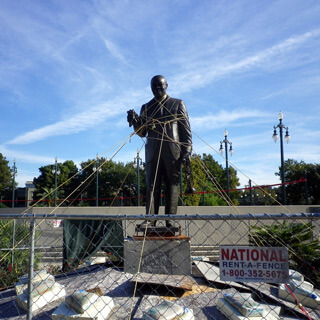Overview
Justin Nystrom describes the labor history of the New Orleans longshoreman and presents the Loyola Documentary and Oral History Studio project On the Waterfront: Conversations with New Orleans Longshoremen.
"The Vanished World of the New Orleans Longshoreman" was selected for the 2014 Southern Spaces series Spaces of Southern Labor, a collection of innovative, interdisciplinary publications drawn from the Southern Labor Studies Association meetings about working class history, politics, and life. The collection is edited by Jana Lipman and Steve Striffler.
The Vanished World of the New Orleans Longshoreman
A popular tourist attraction in New Orleans today is the "Moonwalk," a brick-paved promenade stretching along the Mississippi riverfront from the Covention Center in the city's Central Business Disrict to the Governor Nicholls Wharf at the downriver end of the French Quarter. Along its length, one finds the Aquarium of Americas, the Steamboat Natchez, and grassy Woldenberg Park. Sitting here on a blanket on a sunny April afternoon during French Quarter Fest, it would be easy to miss that only forty years ago this entire recreational complex was an industrial landscape of wharves and warehouses. Other than witnessing the constant parade of cargo vessels plying the river or driving past the looming cranes of the Nashville Avenue terminal, it is almost impossible to come into visual contact with port activity in New Orleans. This is true despite the fact that the American Association of Port Authorities ranks it as the nation's fifth largest port in terms of total tonnage.1Statistics on port volume available at American Association of Port Authorities, accessed March 4, 2014, http://www.aapa-ports.org. Automation has transformed global shipping in the last four decades and divorced port activity from the daily lives of the city's inhabitants, a separation that fundamentally altered the social, economic, and cultural landscape of New Orleans. Life on the docks governed the city's tempo for its first two-and-a-half centuries, yet by the next generation, few people will have firsthand memory of the culture of labor and commerce that once thrived along the water's edge.
 |
| Mississippi River Moonwalk, New Orleans, Louisiana, 2011. Photograph by Derek Bridges. Courtesy of Derek Bridges. |
The scale and speed with which the New Orleans waterfront and its adjacent neighborhoods metamorphosized from blue-collar semi-industrial spaces into upper middle class zones occupied by white-collar professionals, tourists, or self-styled bohemians not only signaled a historical break in New Orleans, it mirrored transformations in modern port cities all over the globe. Ever since humankind began sending bulk goods by sea, the systematic loading and unloading of cargoes depended upon a stable and sizable portside workforce, whether Egyptian laborers in Alexandria stowing sacks of grain bound for fourth-century Rome or New Orleans longshoremen hauling bales of cotton destined for the looms of nineteenth-century England. Automated cargo systems invented in the 1950s ultimately severed this ancient continuum and ushered in what the historian John Lewis Gaddis terms a moment of "punctuated equilibrium" in which "processes that led to particular structures took a distinctive, or abnormal, or unforeseen course."2John Lewis Gaddis, The Landscape of History: How Historians Map the Past (Oxford, New York: Oxford University Press, 2002), 99–100. By 1990, most ports needed only a fraction of their former workforce to handle the growing volume of global seaborne commerce. We live in the dawning of a new era in the way the world sends and receives goods. To document life on the docks as recently as the early 1960s is to record the final chapter of a story that reaches into antiquity. Today's port cities are writing the opening pages of their unknowable future.
Legacy of Labor
Before the first container ship sailed into the port of New Orleans, bringing with it the incipient automation of cargo handling of the 1970s, over eight thousand longshoremen worked along the New Orleans riverfront. Hauling everything from bales of cotton and rubber to armored vehicles, this small army of men ensured the steady flow of commerce between the Mississippi River and the rest of the world. This was the era of "breakbulk" cargo, when goods came in sacks, barrels, and bales. Ships were smaller and built differently, requiring cargoes to be stowed and unloaded by hand in between irregularly shaped bulkheads. This job had to be done quickly and carefully so as to maximize storage capacity and maritime safety. Hundreds of men organized into gangs of twenty often worked day and night to unload a single ship.
Unionization of the port workforce reached back to the late nineteenth century. The market for physical labor in New Orleans had always been biracial, and it was no different along the waterfront, where black and white cargo handling unions competed for work along the busy river. In 1935, during the labor-friendly Roosevelt administration, the International Longshoremen Association built on this segregated, sometimes contentious, but often cooperative past, by establishing Local 1418 for white dockworkers and Local 1919 for their black counterparts. For most of the twentieth century, labor divided equally between the black and white unions, and while they often performed difficult and dangerous work, both black and white longshoremen enjoyed steady employment at a decent wage. Life as a longshoreman also offered a degree of freedom and social status that most wage earners envied. "You're hired and fired every day," explained retired longshoreman Robert Blake. Once a ship was fully loaded or unloaded, it meant finding more work at the hiring offices of shipping lines that used to be located at the foot of Canal Street, where Harrah's Casino now stands. At first blush, this suggests employment uncertainty, but the opposite was true. With over 150 shipping companies operating during the midcentury heyday of breakbulk cargo, work was plentiful.
The population of New Orleans was at its peak in 1960 with just under 630,000 inhabitants, or almost twice that of the present-day total, all contained within a smaller footprint. With large tracts of the Orleans Parish suburb of Lakeview and virtually all of New Orleans East undeveloped at that time, the population density was double that of today. The city's wharves extended upriver from beyond the Jefferson Parish line at Southport to St. Bernard Parish, which lay far downriver, and the oldest residential neighborhoods in the city concentrated along this "sliver by the river." Dockworkers dominated the first several blocks in from the waterfront where they lived in the ubiquitous "shotgun double" house, situated within hailing distance of the ships' horns. All along the streets that run parallel to the Mississippi River, from Tchoupitoulas above Canal Street to New Levee in the Central Business District and Decatur Street in the French Quarter, one could find seaman's bars and corner joints that catered to the around-the-clock work routine of the docks. This working man's seaport atmosphere originated during the city's founding in the Age of Sail and spread up and down the city's waterfront with every advance in waterborne transportation. The city's explosive growth in the 1820s and 1830s followed the introduction of riverine steam power, while its rise as a produce and grain hub emerged with the advent of steel oceangoing screw steamers in the 1880s. Incremental innovations on the docks improved the pace and efficiency of cargo handling.
 |
| Let's Make New Orleans a Safe Port of Departure, 1941–1943. Poster by John McCrady. Courtesy of the Library of Congress, Prints and Photographs Division, LC-USZC2-1591. |
Motorized conveyor belts replaced human shoulders in the unloading of bananas in the 1920s, just as gas-powered forklifts took the place of mules and carts after World War II. By 1960, the basic guiding logic of loading and unloading cargoes had not changed fundamentally since the late nineteenth century, and it still required a large workforce.
The Sinking Ship
It did not take long for port cities everywhere to feel the impact of the invention of the standardized twenty-foot steel shipping container. Introduced in 1956, this innovation not only rendered much of the world's cargo fleet obsolete, it redefined the basic building block of global commerce. With containers, a crane operator and a dozen skilled loaders might do the job of hundreds of longshoremen in a fraction of the time and cost with substantially less damage to the cargo.3For a detailed treatment of how containerization revolutionized global shipping and commerce see Marc Levinson, The Box: How the Shipping Container Made the World Smaller and the World Economy Bigger (Princeton, NJ: Princeton University Press, 2006). Although competing cities grasped the implications of this new technology and implemented sweeping infrastructure improvements, the Port of New Orleans, hobbled by a dock board populated by political appointees who possessed no useful knowledge of the shipping industry, proved slow to adopt facilities capable of handling "the box," choosing instead to bank on its historical geographical advantages in grain, petrochemicals, coffee, and other bulk commodities.4The New Orleans Times-Picayune ran an influential eight-part series on the decline of the port in 1982. See Christopher Drew, "Flagship of Area's Economy Losing Out to Hustling Rivals," The Times-Picayune, June 13, 1982. Containers first appeared in New Orleans at an inadequate facility built on the Industrial Canal in 1973, but proved an overall failure. Gantry cranes, designed to lift containers from a ship's deck, did not enter service until 1998. Although the net value of shipping continued to increase during this period due to trade in grain and petroleum, the number of people required to operate the port declined sharply. Meanwhile, more valuable cargoes went increasingly to other cities with better rail infrastructure. As geographer Richard Campanella observes, "great ports no longer really needed great port cities."5Richard Campanella, Bienville's Dilemma: a Historical Geography of New Orleans (Lafayette: Center for Louisiana Studies, University of Louisiana at Lafayette, 2008), 232. Even bananas, the most emblematic cargo of the once powerful New Orleans–based United Fruit Company, left for Gulfport, Mississippi in the 1970s. By 1980, the declining Locals 1418 and 1919 finally integrated, forming the ILA Local 3000, due to both the legally untenable nature of segregated memberships and the poor prospect of survival in the face of declining numbers.
 |
| United Fruit Company banana conveyors, New Orleans, Louisiana, 1910. Courtesy of the Library of Congress, Prints and Photographs Division, LC-DIG-det-4a19873. |
"I Just Liked to Be in that Number": The Longshoremen Remember
The transformative impact of the port's automation upon the history, culture, economy, and demographics of New Orleans became a topic of conversation in the spring of 2012 between Justin Nystrom, the director of Loyola University New Orleans's new Documentary and Oral History Studio, and Mark Ellis, who served as the secretary-treasurer of the ILA Local 3000 for twenty-eight years. With the support of union president Kenneth Crier, Nystrom structured an oral history project aimed at recording stories of those men who belonged to the last generation of longshoremen to participate in the centuries-old system of breakbulk cargo. The Loyola Documentary and Oral History Studio fuses traditional oral history methodology with the high production value recording found in modern documentaries. These recording procedures afford flexibility in dissemination. Archived as both transcript and ten-bit digital video, interviews serve as source material for textual scholarship and documentary features.
 |
| Justin Nystrom and students Kyleah Frederic, Eric Buras, and Kaleigh Macchioand prepare equipment for a recording session, Loyola University, New Orleans, Louisiana, October 29, 2012. Photograph by Harold Baquet. Courtesy of Harold Baquet and Justin Nystrom. |
Longshoremen interviews began in the fall of 2012 as part of Nystrom's senior seminar in oral history taught at Loyola University New Orleans. Nine students each recorded and transcribed one full interview and took turns aiding with technical production during the recording sessions by setting up lighting, microphones, and camera equipment. Successful interviews required students to bridge significant differences in age, economic background, gender, and education between themselves and the interviewees. Students also assembled research folios on the life of New Orleans longshoremen using historical newspapers and other textual sources in order to prepare informed questions for their interview subjects, in addition to more general questions about life on the docks. Other challenges included scheduling. As Mark Ellis observes, longshoremen always worked by the job, not the clock. At the semester's conclusion, the class had recorded six hours of interview footage. A final class project tasked students with identifying themes from the collective body of interviews and editing thematically-linked footage into a focused narrative. This documentary short reflects some of the selections made during their coursework.
A recurring theme in the interviews for On The Waterfront: Conversations with New Orleans Longshoremen is a fond, if nostalgic, memory of life on the docks. "They had a lot of mens, and everything, and I just liked to be in that number," explains longshoreman John McSwain, who came to New Orleans from rural Alabama in 1959 at the age of nineteen to work on the river. James McCleland started at eighteen in 1949, drawn by the atmosphere of the docks where his father spent fifty years. "He wanted me to go to college, and I was hard headed and wouldn't go to college," recalls McCleland, "and he didn't want to bring me on the waterfront, but his boss did, and between them they worked it out." McCleland's father echoes the wishes about college that his son would later express to his own children.
On the Waterfront: Conversations with New Orleans Longshoremen, 2014. Produced by the Loyola Documentary and Oral History Studio.
Stories of accidents also figure prominently in longshoremen's memories. "I mean you can hear a strange noise in the middle of a conversation and hear that noise and everyone knows to just start running," observes Chris Hammond. "Because we know that that noise is something breaking, like a cable snapping." On his first day on the job, John McSwain suffered two broken feet when a crane lowered a "household box" onto them. Later, as a foreman, he witnessed a major collision on the river: "They had a ship collided with a oil barge. And twenty-six mens went down with the ship. Up under the bridge, out there . . . by the Crescent City Connection. . . . Yeah, was Easter Sunday night, we were working out there. Sure was at Julia Street. Julia Street Wharf."
The Longshoremen tell of the tedium of loading 250-pound sacks, the oppressiveness of the heat working inside a ship's hold in the summer, and the relentless pace. But they also tell of the camaraderie of life on the docks, steady work, good wages, and a responsive union. One recalls when Martin Luther King came to speak at the Local 1919 union hall on Claiborne Avenue in 1961, while others remember overcoming fears of snakes and spiders sleeping among the refrigerated bananas. Each expresses keen awareness that the world in which they worked is gone.
The transcribed interviews from this project, along with their accompanying video files, are deposited in the Loyola Archives and Special Collections, to be made available to scholars online through the LOUISiana Digital Library. Additionally, student workers in the Documentary and Oral History Studio are building a Zotero database that will enable other Zotero users to search full-text transcripts and view video files.
The "Sliver by the River"
Today, New Orleans's working riverfront carries on behind a concrete sea wall, cordoned off from the neighborhoods whose rhythms once moved to the steady arrival and departure of cargo ships along the docks. This modern complex has its own rail line and semi-truck express lane, while the cranes and gantries that pluck containers from the decks and hulls of oceangoing vessels employ fewer than five hundred skilled longshoremen. This comparatively compact, efficient, and heavily automated modern port facility replaced the miles of open wharves, which continue to rot and tumble into the river.
 |
| Decaying wharves, Felicity Street, New Orleans, Louisiana, 2010. Photograph by Justin Nystrom. Courtesy of Justin Nystrom. |
Their decay passes unnoticed in a labor market that has shifted toward the service industry, technology, and tourism, while college-educated professionals convert the shotgun doubles lining the streets that radiate perpendicularly from the river's crescent like the ribs of a fan into stylish single-family homes. Located on the historical high ground, a combination of aesthetics, demographics, and FEMA flood map designations have rendered this "sliver by the river" the most expensive real estate in the postdiluvian city. The transition taking place here is not unlike the sort of gentrification unfolding in the urban centers of other US cities, but the architecture and street grid still bear the imprint of the once relationship between land and river. 
About the Author
Justin Nystrom is Assistant Professor of History, Co-Director of the Center for the Study of New Orleans, and Director of the Documentary and Oral History Studio at Loyola University New Orleans.
Recommended Resources
Text
Arnesen, Eric. Waterfront Workers of New Orleans: Race, Class, and Politics, 1863–1923. Champaign: University of Illinois Press, 1994.
Powell, Lawrence N. The Accidental City: Improvising New Orleans. Cambridge, MA: Harvard University Press, 2012.
Rosenberg, Daniel. New Orleans Dockworkers: Race, Labor, and Unionism 1892–1923. Albany: State University of New York Press, 1988.
Solnit, Rebecca and Rebecca Snedeker. Unfathomable City: A New Orleans Atlas. Berkeley: University of California Press, 2013.
Web
LOUISiana Digital Library, http://louisdl.louislibraries.org.
United Fruit Historical Society, http://www.unitedfruit.org.
Similar Publications
| 1. | Statistics on port volume available at American Association of Port Authorities, accessed March 4, 2014, http://www.aapa-ports.org. |
|---|---|
| 2. | John Lewis Gaddis, The Landscape of History: How Historians Map the Past (Oxford, New York: Oxford University Press, 2002), 99–100. |
| 3. | For a detailed treatment of how containerization revolutionized global shipping and commerce see Marc Levinson, The Box: How the Shipping Container Made the World Smaller and the World Economy Bigger (Princeton, NJ: Princeton University Press, 2006). |
| 4. | The New Orleans Times-Picayune ran an influential eight-part series on the decline of the port in 1982. See Christopher Drew, "Flagship of Area's Economy Losing Out to Hustling Rivals," The Times-Picayune, June 13, 1982. |
| 5. | Richard Campanella, Bienville's Dilemma: a Historical Geography of New Orleans (Lafayette: Center for Louisiana Studies, University of Louisiana at Lafayette, 2008), 232. |




